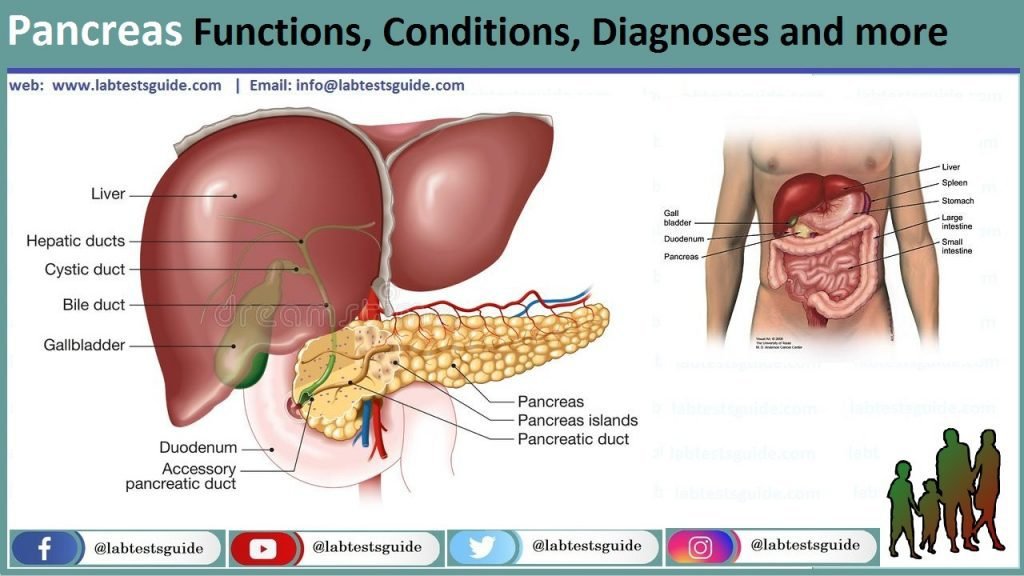The pancreas is an organ located in the abdomen. It plays an essential role in converting the food we eat into fuel for the body’s cells. The pancreas has two main functions: an exocrine function that aids in digestion and an endocrine function that regulates blood sugar.

Function of pancreas:
A healthy pancreas produces chemicals to digest the food we eat.
Exocrine tissues secrete a clear, watery, alkaline juice that contains various enzymes. These break down food into small molecules that can be absorbed by the intestines.
Enzymes include:
- Trypsin and chymotrypsin to digest proteins
- Amylase to break down carbohydrates
- Lipase, to break down fats into fatty acids and cholesterol.
The endocrine portion, or islets of Langerhans, secrete insulin and other hormones.
Pancreatic beta cells release insulin when blood sugar levels rise.
Insulin:
- moves glucose from the blood to muscles and other tissues, to be used for energy
- helps the liver absorb glucose, storing it as glycogen in case the body needs energy during stress or exercise
When blood sugar drops, pancreatic alpha cells release the hormone glucagon.
Glucagon causes glycogen to break down into glucose in the liver.
The glucose then enters the bloodstream, restoring blood sugar levels to normal.
Pancreas conditions:
- Diabetes, type 1: The body’s immune system attacks and destroys the insulin-producing cells of the pancreas. Lifetime insulin injections are required to control blood sugar.
- Diabetes, type 2: The body becomes resistant to insulin, which causes a rise in blood sugar. The pancreas eventually loses the ability to properly produce and release insulin, leading to the need for synthetic insulin.
- Cystic fibrosis: A genetic disorder that affects multiple body systems, usually including the lungs and pancreas. Digestive problems and diabetes often result.
- Pancreatic cancer: The pancreas has many different types of cells, each of which can lead to a different type of tumor. The most common type arises from the cells that line the pancreatic duct. Because there are usually few or no early symptoms, pancreatic cancer is often advanced by the time it is discovered.
- Pancreatitis – The pancreas becomes inflamed and damaged by its own digestive chemicals. Swelling and death of the pancreas tissue can occur. Although alcohol or gallstones can contribute, sometimes the cause of pancreatitis is never found.
- Pancreatic pseudocyst: After an attack of pancreatitis, a fluid-filled cavity called a pseudocyst can form. Pseudocysts may resolve spontaneously or may require surgical drainage.
- Islet cell tumor: The hormone-producing cells of the pancreas multiply abnormally and create a benign or cancerous tumor. These tumors produce excessive amounts of hormones and then release them into the blood. Gastrinomas, glucagonomas, and insulinomas are examples of islet cell tumors.
- Enlarged pancreas: An enlarged pancreas is rare. It can be a harmless anatomical abnormality or it can be a sign of autoimmune pancreatitis.
Pancreas tests:
- Physical exam: By pressing on the center of the abdomen, a doctor can check for lumps or abdominal pain. They can also look for other signs of pancreas conditions. Pancreatic pain often radiates to the back.
- CT scan: A CT scanner takes multiple X-rays and a computer creates detailed images of the pancreas and abdomen. Contrast dye may be injected into your veins to improve the images.
- Magnetic Resonance Imaging (MRI): Magnetic waves create highly detailed images of the abdomen. Magnetic resonance cholangiopancreatography (MRCP) is an MRI that focuses on the pancreas, liver, and biliary system.
- Endoscopic retrograde cholangiopancreatography (ERCP): With a camera on a flexible tube that is advanced from the mouth to the intestine, a doctor can access the head area of the pancreas. Small surgical tools can be used to diagnose and treat some conditions of the pancreas.
- Pancreas biopsy: Either with a needle through the skin or through a surgical procedure, a small piece of tissue is removed from the pancreas to look for cancer or other conditions.
- Endoscopic ultrasound: A probe is placed in the abdomen and harmless sound waves create images by reflecting off the pancreas and other organs.
- Amylase and lipase: Blood tests that show elevated levels of these pancreatic enzymes may suggest pancreatitis.
- Chloride sweat test – A painless electrical current stimulates the skin to sweat and chloride in perspiration is measured. People with cystic fibrosis often have elevated levels of chloride in their sweat.
- Genetic testing: Many different mutations in a single gene can cause cystic fibrosis. Genetic testing can help identify whether an adult is an unaffected carrier or whether a child will develop cystic fibrosis.
Related Content
| Keywords: Disease, Pancreatic, Diseases, Pancreatic, Pancreatic Disease, Pancreatic Diseases, Unspecified disease of pancreas, Diseases of pancreas, pancreas disorder, Disease of pancreas, Diseases of pancreas NOS, Disease of pancreas, unspecified, PANCREATIC DIS, pancreatic disorders, pancreatic disorders (diagnosis), Disorder pancreas, Pancreas disorder, Pancreatic disorder NOS, Pancreatic disease NOS, Pancreatic Diseases [Disease/Finding], disease pancreatic, disorders pancreas, diseases pancreatic, pancreatic disease, diseases pancreas, Disease;pancreas, diseases of pancreas, pancreatic disorder, of pancreas disease, pancreas disease, pancreas diseases, diseases pancrea, disorders pancreatic, pancreatic diseases, disease pancreas, diseases of the pancreas, Diseases of pancreas NOS (disorder), Pancreas–Diseases, Pancreatic disorder, disease (or disorder); pancreas, Disease of pancreas, NOS, Disorder of pancreas, NOS, Disorder of pancreas, Disease of pancreas (disorder), Disorder of pancreas (disorder), Pancreatic Disorder, disease of the pancreas |
RELATED POSTS
View all

